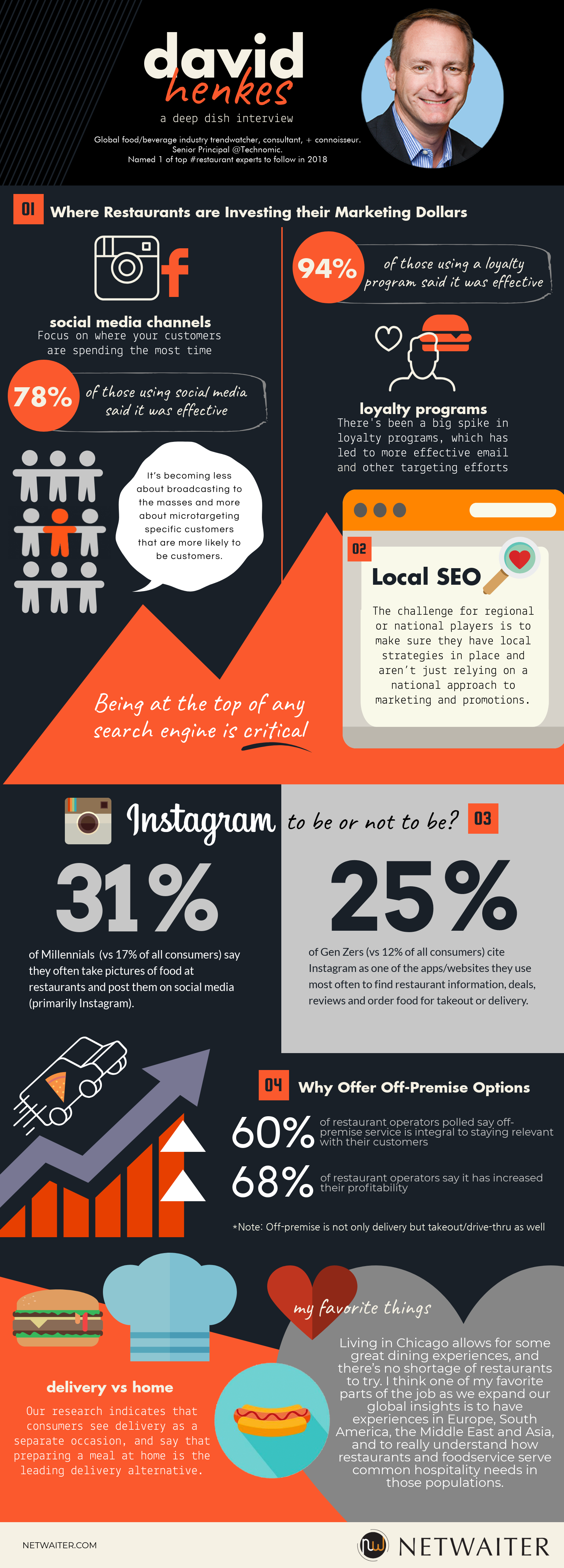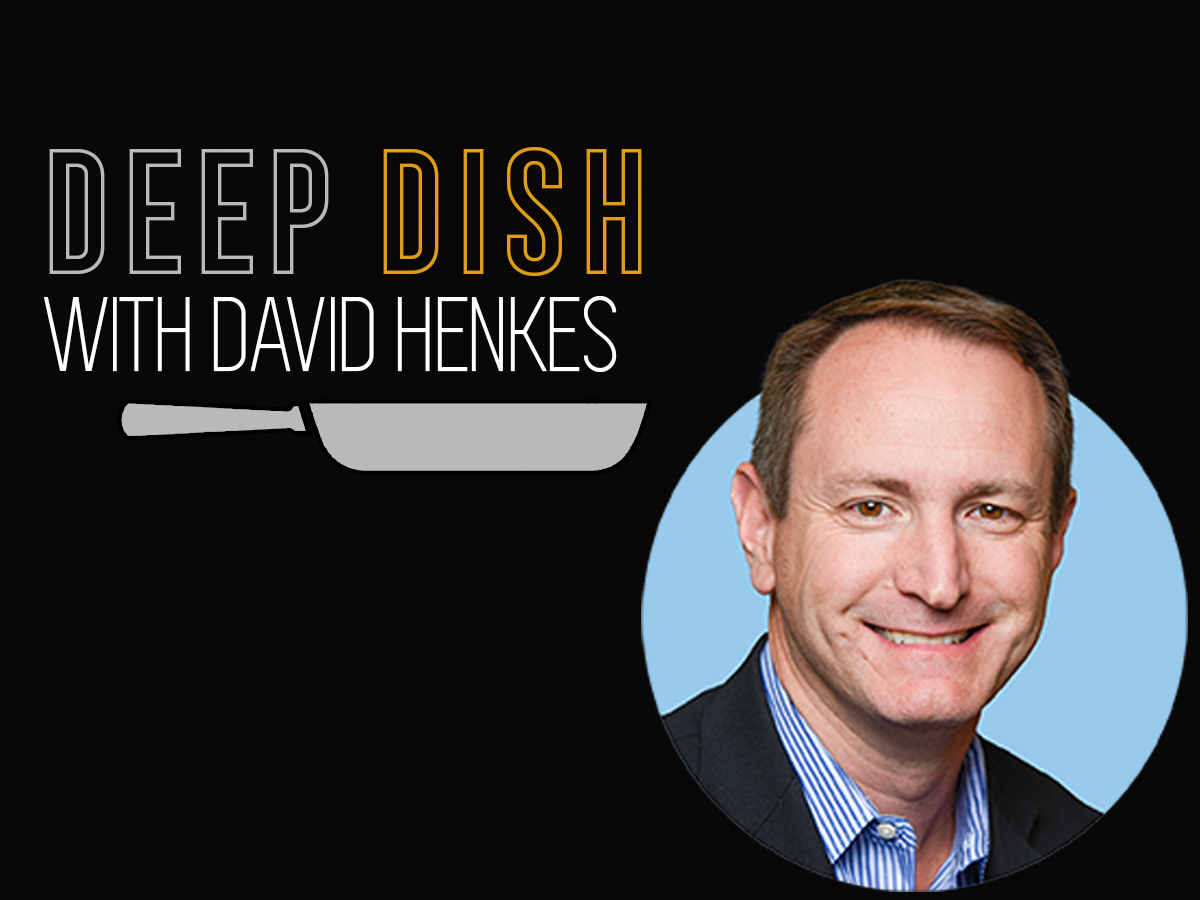Over the next few months, we will be featuring restaurant industry leaders and influencers that will hopefully inspire you and your path within this delicious industry. Be sure to follow them on Instagram, Twitter and/or Facebook!
Next in our “Deep Dish” series is David Henkes. Dave is a well-known commentator in the food and beverage industry and has appeared on regularly on Bloomberg TV, Thompson Reuters, CNBC,Fox Business, MSNBC, CBS, NPR, ABC and First Business, among others. He has been cited by a wide variety of sources, including The Wall Street Journal, TheStreet.com, Time Magazine, Crain’s Chicago Business, Reuter’s and Associated Press syndicated articles, as well as industry trade magazines such as Restaurant Business, Nation’s Restaurant News, Beverage Industry Magazine, and others.
As a senior member of the firm at Technomic, his specific responsibilities include client development, engagement oversight, and industry relations. His range of experience is wide and includes market and strategic planning, customer satisfaction benchmarking, opportunity analyses, acquisition due diligence evaluations, new product evaluation and concept testing, usage/attitude analyses, and distribution systems analyses. He also oversees the firm’s Beverage Practice.
Before joining Technomic, Dave gained international food experience working with Nestle Germany in Frankfurt, Germany. With his international experience, Dave has conducted studies in many European countries as well as Mexico and Canada. Prior to his food industry work he also worked as a federal investigator in Washington, DC.

First, it’s important to note that restaurant growth remains challenged, despite what’s been a pretty strong economy in terms of employment, income growth, etc. We continue to see operators struggle to grow topline growth, and traffic figures remain stagnant. In fact, we did an analysis last year that showed of the total dollar growth in the restaurant industry over the past five years, 60% of that came from price increases, and 40% came from mix change (i.e. swapping out menu items, focusing on higher priced items, etc.) None of the aggregate growth came from traffic. Overall, we feel that the industry is probably still saturated (or oversaturated), with too many locations chasing too few consumer dollars, and as a result the total industry isn’t seeing much growth. As a result, having a strategy to generate incremental spending is critical.
1. Where are restaurants investing their advertising and marketing dollars?
More and more, restaurants need to spend in areas that will be most impactful. The challenge for operators is developing messages and promotions that break though the noise and creating action on the part of the consumer. From an advertising perspective, this means more focus on where the consumers spend their time, including social media channels – sites like Instagram, YouTube, Twitter, Untappd, Snapchat, even Facebook. But perhaps even more importantly, operators need to understand their customers, and we’ve seen a big spike in loyalty programs, which then lead to more effective email and other targeting efforts. In a recent survey, 94% of operators that use a loyalty program said it was effective; 78% of those using social media said that’s effective, so results on both are both seen as generally positive. Overall, I think a good summary is that it’s becoming less about broadcasting to the masses and more microtargeting specific customers or types of consumers that are more likely to be customers. As technology continues to evolve, restaurants will increasingly be able to use data analytics to be smarter about who’s being targeted and where.
2. How important is local SEO to a restaurant?
Consumers use a wide variety of sources to find new restaurants to try, and being at the top of any search engine is critical. Independent operators get this; the challenge for regional or national players is to make sure they have local strategies in place and aren’t just relying on a national approach to marketing and promotions. Any type of local marketing has to include things like Yelp and TripAdvisor; those that participation in 3rd party delivery also will (or should) have a strong local presence on apps like GrubHub, DoorDash, etc.
3. Instagram – to be or not to be?
Instagram is rapidly growing in importance, particularly to the younger consumer. In a recent survey we found that 17% of consumers (23% of Gen Zers and 31% of millennials) say they often take pictures of food at restaurants and post them on social media (primarily Instagram); further more, 12% of consumers (and 25% of Gen Zers) cite Instagram as one of the apps/websites they use most often to find restaurant information, deals, reviews and order food for takeout or delivery. Importantly, this should be only one aspect of a larger sales and marketing approach, but Instagram (and social media more generally) is generally seen as an effective way to reach your customers.
4. Should restaurants offer delivery?
Delivery is a huge growth area right now; as restaurants are finding it more difficult to generate traffic and get people to come to them, they need to be able to go to the consumer. Overall, 60% of restaurant operators polled say off-premise service is integral to staying relevant with their customer base and 68% say it has increased their profitability (note that off-premise is not only delivery but takeout/drive-through as well). Specifically on delivery, the attitude from restaurant operators really shows that participating in delivery is shifting towards becoming a table stake and can help broaden the customer base, particularly since these “off-premise/delivery” occasions are not cannibalizing in-store sales. Our research indicates that consumers see delivery as a separate occasion, and say that preparing a meal at home is the leading delivery alternative.
5. And a for fun question – What has been your most favorite dining experience?
Living in Chicago allows for some great dining experiences, and there’s no shortage of restaurants to try. My wife and I along with some friends try to get to as many local breweries as possible, and we try to dine downtown a couple times a month to keep up with all of the new restaurants as well as continue to visit some old favorites. I’m also fortunate to get to travel internationally, and I think one of my favorite parts of the job as we expand our global insights is to have experiences in Europe, South America, the Middle East and Asia, and to really understand how restaurants and foodservice serve common hospitality needs in those populations.


